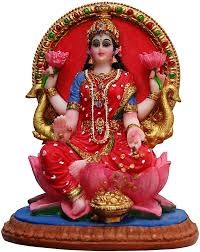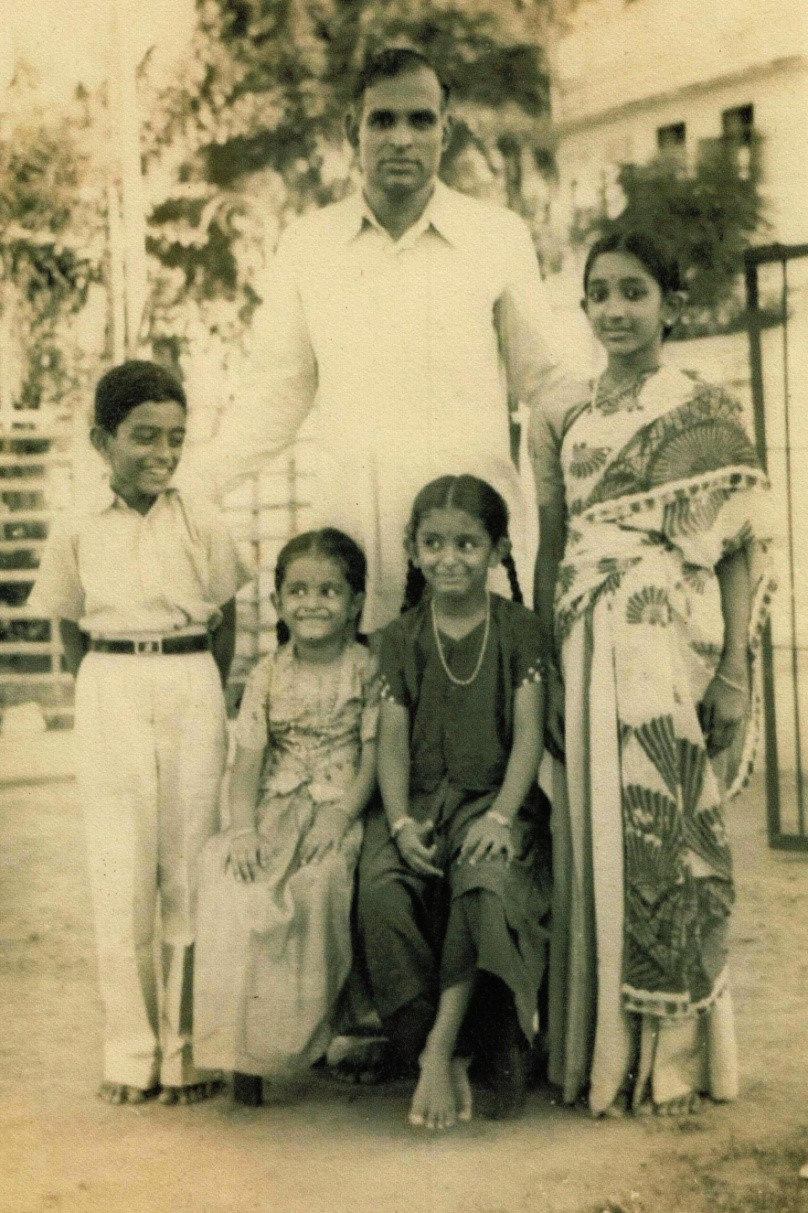Navarathri Kolu: A Continuing Family Tradition
Category:
Tags:

Kamakshi Balasubramanian is a retired educator living in Mysore. She is an occasional writer. Her interests include cinema, popular culture, travel (particularly within India), and sewing by hand. Kamakshi received her higher education in India, the erstwhile U.S.S.R., and the U.S.A. She speaks Tamil, English, and Russian fluently, and knows Hindi.
For over 50 years, my sister Savithri has continued to follow an age-old southern-Indian tradition in Hindu families: Navarathri Kolu.
In the households that follow this tradition, the family sets up an arrangement of handmade figures made of wood or clay. The figures are generally religious divine beings, such as images of Vishnu reclining on a magnificent snake, Shiva in his exquisite dancing form, Lakshmi seated on a pink lotus, sometimes the Buddha under the Bodhi tree, and of course, Ganesha, without whose presence nothing auspicious ever gets off the ground in Hindu households.

Clay doll depicting Goddess Lakshmi on a pink lotus. Sourced from internet.
The dolls or figures also represent everyday beings, far removed from the celestial divinities. A typical Kolu display often has little tableaux, depicting events such as a wedding with musicians and priests surrounding the bridal couple seated in front of a holy fire. Village scenes of farmers ploughing a field, women carrying water on pots balanced on their heads, and of simple folk hard at work cooking, sewing, weaving, herding sheep become expressive and colourful dolls in the hands of traditional doll-makers for the Kolu.
As a young girl, I loved dolls that showed children at play or swimming in village ponds.

Village scene lit up with fairy lights in a Kolu arrangement. Sourced from internet.
Then there are the wooden dolls-mostly of gods, birds, and folk dancers and musicians. Kondapalli dolls are especially famous for their stylized faces and colourfully painted designs. The Tirupathi wooden dolls are dark or light brown, no paint, and have a special place in a Kolu.

Our family hasn't ever been big on elaborate Kolus, primarily because my father was not one for accumulating things or for pomp of any sort. Besides, we moved from place to place in India as long as he was a working man, because his tenure in Indian government service required him to move wherever he was posted. Obviously, we couldn't lug extra cases of dolls. My father might have said. Dolls? Dolls?!

From left to right, Ramesh, Radha, Kamakshi, and Savithri
Behind, T. V. Balasubramanian (father) 1953. (Photo by cousin Natesan).
When we were all young, in the 1950s and early 1960s. our mother would set up a small display. We had a few images of Hindu gods, a small number of animal figures, randomly bought over the years, even porcelain dolls from Europe, which had no relationship to Navarathri, yet sat serenely in their hats and frocks, shiny, pearly white, among the humble clay figures.
A few of the figures that my mother had continue to adorn my sister's arrangement. They are over 70 years old.
My mother (her autobiography is available here) also liked to put up traditional oil lamps as well as untraditional garlands made of paper flowers, which we ourselves often made with great enthusiasm. There was one feature always unique to my mother's Kolu that attracted attention, however small or modest the dolls display. That was the Muthal Aarathi or a rangoli design displayed on a large round silver plate. The outline was defined by neatly arranging small white round pellets made of finely ground rice paste, each pellet no larger than a peppercorn.
Once the outline was made, the spaces inside would be filled with colours. Not for my mother store-bought colours-she only used turmeric, kum-kum, rice flour, and combined these to get lighter shades.

A simple Muthal Aarati by Savithri. 2012.
All of us in our family got adept at this, and took great pride in our skill. A tiny silver lamp would be lit every evening and placed in the centre of the rangoli to give it a glow. Only occasionally would mother allow us to bypass the laborious rice paste and pellets routine. Those times we used sago.
My sister, Savithri, whose Kolu has inspired me to write this piece, has continued to display such a rangoli every year.
Savithri is the eldest of the four of us siblings. She and my youngest sister have inherited my mother's practices of worship of the divine. Savithri has lived in India all her life, whereas my younger sister has lived abroad a large part of her adult life. Perhaps this is one reason for Savithri's ability to preserve traditions with which she grew up. Her married home greatly appreciates her determination to preserve family traditions. She has two daughters, and as a young mother, she enjoyed observing rituals of food, dressing up, and celebration on religious festivals that involved the participation of girls and women.
Savithri studied history in high school and college. She has a deep interest in the evolution of religious practices in the community to which she belongs. She visits temples around India, reading extensively about them, their history, and their architecture, trying to relate her rituals to ideas she has absorbed from the myths associated with each deity. For example, during Navarathri, she will recite special slokas daily in praise of the goddess who slayed the demon.

Savithri. 2012
Savithri told me that the arrangement of dolls generally follows a pattern. Divinities are placed on the highest row, the ordinary mortal activities and figures occupy the middle rows, and animals and toys find themselves on the lowest rows She doesn't usually even bother with too many dolls that depict the worldly life, preferring to use the Kolu display to venerate divine beings.
Once arranged, and once the festival of Navarathri had begun, it was important not to disturb the dolls in any way. Each doll remained in its place, and couldn't be moved until the last day, when ceremonially, late in the evening on Vijayadashami, one dolls was laid on its side to signal that these figures could now rest.
There was a story to explain why the dolls couldn't be moved. In our tradition, the Navarathri Kolu was set up in honour of a goddess called Mahishasura Mardhini, an incarnation of Durga, and the slayer of Mahishasura, the demon.

Mahishasura Mardhini slaying Mahishasura, the demon. Sourced from internet.
In order to gain the physical and spiritual power needed to vanquish Mahishasura, the goddess is supposed to have stood on the tip of a needle for nine days and nine nights in rigorous penance. Thus, the dolls denote the rigour of that penance. For the duration of the nine days, women in our families wouldn't sew, because that sharp end was the pedestal for the goddess in her penance.
It is customary to erect a stand for the dolls. This stand consists of steps as in a stairway. Today, of course, these stands can be bought online.

Fancy modern Kolu stand. We had nothing like this!
Usually there are five or more odd-numbered steps in such a stand, which was especially made for the Kolu arrangement, and then packed away after the festival. The width would depend on the dimensions of the room where this stand was to be erected.
The entire structure used to be covered with clean white dhotis, for the most part used ones, because the Kolu stand with its rather rough planks and many protruding nails would be unkind to the cloth covering. In the old days, Tamil magazines never tired of jokes about missing dhotis, mostly innocuous but not always. I imagine that more colourful textiles or even reusable synthetic sheets have replaced the humble, used dhoti's function in today's Kolu.
Dolls used for the Kolu are packed up and stored away at the end of the season. Other than the odd wooden doll from Tirupathi (the marappachi), during the rest of the year, one didn't have these dolls on display. Packing the dolls away was sometimes a bigger chore than unpacking them to display, because, one had to be careful not to damage the god images with their four hands, curved trunks, and leg raised chest high in a dance pose. The farmers had their ploughs, the wells had their pulleys, and the bulls had their horns.
While much of the festival-related activities involve women, men enjoy the special food prepared every evening. Navarathri is a time for visiting one another in the evening. Every family would prepare a snack made of boiled pulses and coconut to be first symbolically offered to the goddess Mahishasura Mardhini, and later distributed to visitors. Women would receive betel leaves and areca nuts, turmeric, and a small packet of this delectable snack.
Traditionally, men didn't go visiting with women, but keenly waited for the snack packets when the womenfolk returned home. This snack called sundal is rarely prepared other than during Navarathri in most homes that I know. If you really want to enjoy it off-season, today you could go to the Marina beach in Chennai, where it is vendors tempt you with sundal as you enjoy the sea-breeze.
These three photos of Navarathri decoration in my sister's home are special\; they continue the tradition that my mother followed.

Kolu in Savithri's home. 2017
The Navarathri dolls display is called Kolu in Tamizh (Ed.: Tamil is the anglicized version of Tamizh). Following tradition, Savithri's Kolu follows is set up on steps that resemble a staircase. My sister likes to draw designs on brass plates, as was our practice when we used to decorate the space around the stand.

Kolu in Savithri's home. 2017
The clay figures of the beloved foursome from the Ramayana - Rama, Sita, Lakshmana, and Hanuman - are made of clay. This set used to be in our home as long as we can remember. Savithri has preserved this set. She continues to display it in her traditional Kolu.

Kolu in Savithri's home. 2017
The figure in white with the veena (stringed instrument) is Saraswathi. the goddess of learning. This figure also has been in our home for decades.
Goddess Saraswathi has a very special place in the celebration of Navarathri. There is a day dedicated to worship of this goddess, usually the ninth day, when in our family (as children) we used to stack up books in front of the Kolu, and offer our humble prayers with flowers and lighting of lamps. On the next day, we would all sit down in front of the Kolu and pick up a book to read, praying for knowledge and wisdom. Those who could sing or play an instrument would offer a performance in worship.
I always loved Vijayadasami day, when we gathered to read and sing, because my mother was a gifted vocalist. Even today, although I haven't put up a Kolu in ages, on Vijayadasami, I catch myself humming a song about Saraswathi "who permeates the white lotus and the sound of the stringed veena"-the Subramanya Bharati song made memorable for me in the rendering of Madurai Mani Iyer.
https://www.youtube.com/watch?v=nlbqnD-eQyo
Thanks to Savithri, we continue to enjoy all the charm and beauty of Navarathri. Kudos, Savithri!
© Kamakshi Balasubramanian 2017
Add new comment